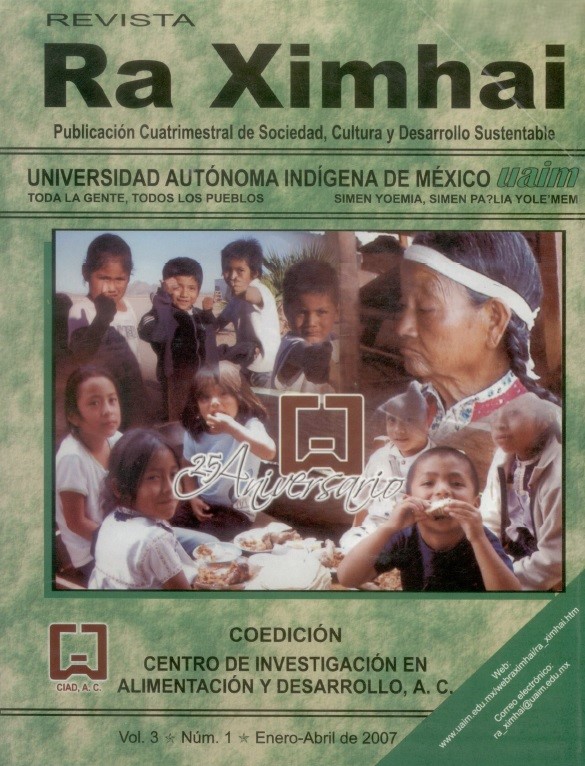Endogenous development and peasant strategies in a Cholulteca community. The case of San Miguel Papaxtla, Tecuanipan, Puebla
DOI:
https://doi.org/10.35197/rx.03.01.2007.06.jcKeywords:
peasant, Smallholding, Cholula, traditional agricultureAbstract
This work was carried out in the valley of Puebla, in which the Cholula region is located, characterized by being a pre-Hispanic population settlement, with little land for cultivation, where the great majority of agricultural producers are smallholders. We tried to reconstruct the productive trajectory used for more than fifty years by the peasants of San Miguel Papaxtla, these being rainfed producers and without common land. This study was carried out from the theoretical perspective of endogenous development. The aspect that was taken into account for its realization was the strategy that the peasants have used for survival as such, these being smallholders, traditional farmers who to this day live and reproduce in the community. The productive historical reconstruction of the community was carried out from 1950, for this reason all the people born before 1940 in the community were interviewed, with a participatory approach. The results obtained showed that the farmers of the community have developed in an endogenous manner, the strategies they have followed have been the maximum use of humidity, the adoption and adaptation of new crops and the way of marketing their products. By the end of 2006 they will have a new resource available, water. This will probably intensify the use of the land and at the same time the introduction of new crops.
Downloads
References
Bonfil B. G. 1988. Cholula, ciudad sagrada en la era industrial. Ed. Universidad Autónoma de Puebla, México.
Canales, A. 1988. Viejas y nuevas polémicas. En Zepeda P. Jorge (editor), Las sociedades rurales Hoy, Ed. El Colegio de Michoacán-CONACYT, México.
Casarrubias, I. L. 1990. Mi patria chica. Gobierno del Estado de Puebla - Secretaría de cultura. México.
Corona, T. L. 1999. Teorías económicas de la tecnología. Ed. Jus. México. pp.7-18. García, C., 1974. Und Bevöl Kerung 1900-1970. Erlanger.
García R. C. 2000. El Altepetl. Origen y desarrollo. Ed. Colegio de Michoacán. México. pp. 79-134.
Gerhard, P. 1986. Geografía histórica de la nueva España (1519-1821). Ed. UNAM-IIH, México,pp. 116-119.
−−−−INEGI. Anuario estadístico 2006, Tomo I y II, México.
−−−−INEGI. (1992). VII Censo Agrícola-Ganadero 1991, México.
−−−−INEGI. Censo de población y vivienda, 1950,1960,1970,1980,1990,2000, México.
Palacios, E. 1982. Puebla y su territorio. 2a edición, Junta de Mejoramiento Moral, Cívico y Material del municipio de Puebla. México. pp.281-287.
Remmers, G. G. A. 2002. El Desarrollo endógeno en zonas rurales: Acertando en un blanco móvil. España. pp.4-13.
Saravia, D. 2003. Desarrollo endógeno y estrategia nacional de desarrollo. Artículo de Internet. Nicaragua. pp.20.
Solana C. M. Del C. 1995. Cholula. Ed. revista Arqueología mexicana, No. 13, mayo- junio. México. pp. 24-30.
Tichy, F. S. 1974. Und Bevöl Kerung 1900-1970. Erlanger.
Toledo, V. C. J. y González C. 1988. La producción rural en México, alternativas ecológicas. Ed. Fundación Universo Veintiuno-UNAM. México.pp.151-218.
Torres, C. G. 1995. El minifundio en una estrategia alternativa de desarrollo. Ed.
Universidad Autónoma Chapingo. México. pp. 9-143.
Toxqui, F. M. G. 2001. Espacio y propiedad territorial indígena en la provincia de Cholula, 1650-1710. En Cervantes B. Francisco (Coordinador). Las dimensiones sociales del espacio en la historia de Puebla (XVII-XIX). Ed. Benemérita Universidad Autónoma de Puebla. México.
Vázquez, B. A. 2002. Desarrollo Endógeno. Universidad Autónoma de Madrid. España, pp.2-10. (En Línea). Disponible en www.apor.pt/Conferencias/vazquez.doc.
Downloads
Published
How to Cite
Issue
Section
License
Copyright (c) 2007 José Isabel Capulín Grande, Juan Francisco Escobedo Castillo, Ignacio Ocampo Fletes , José Pedro Juárez Sánchez , Susana Rappo Miguez

This work is licensed under a Creative Commons Attribution-NonCommercial 4.0 International License.
Usted es libre de:
- Compartir — copiar y redistribuir el material en cualquier medio o formato
- Adaptar — remezclar, transformar y construir a partir del material
- La licenciante no puede revocar estas libertades en tanto usted siga los términos de la licencia
Bajo los siguientes términos:
- Atribución — Usted debe dar crédito de manera adecuada , brindar un enlace a la licencia, e indicar si se han realizado cambios . Puede hacerlo en cualquier forma razonable, pero no de forma tal que sugiera que usted o su uso tienen el apoyo de la licenciante.
- NoComercial — Usted no puede hacer uso del material con propósitos comerciales .
- No hay restricciones adicionales — No puede aplicar términos legales ni medidas tecnológicas que restrinjan legalmente a otras a hacer cualquier uso permitido por la licencia.








